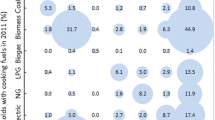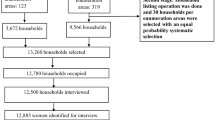Abstract
Objectives: To determine the association between the combustion of wood, animal dung, coal and paraffin (polluting fuels) for cooking and heating and 1–59 month old mortality in South Africa, whilst adjusting for a number of confounders. Methods: Data from 3,556 children (142 deaths) living in 2,828 households were extracted from the 1998 South African Demographic and Health Survey (SADHS) database. The SADHS was the first national health survey conducted across the entire country and provided the opportunity to examine the prevalence and determinants of various morbidity and mortality outcomes in a representative national population. Results: The results suggest that exposure to cooking and heating smoke from polluting fuels is significantly associated with 1–59 month mortality, after controlling for mother's age at birth, water source, asset index and household crowdedness (RR=1.95; 95% CI=1.04, 3.68). Conclusions: Although there is potential for residual confounding despite adjustment, the better documented evidence on outdoor air pollution and mortality suggest this association may be real. As nearly half of households in South Africa still rely on polluting fuels and women of childbearing age perform most cooking tasks, the attributable risk arising from this association, if confirmed, could be substantial. It is trusted that more detailed analytical intervention studies will scrutinise these results in order to develop integrated intervention programmes to reduce children's exposure to air pollution emanating from cooking and heating fuels.
Similar content being viewed by others
References
Katz J, West KP, Jr., Khatry SK, Christian P, LeClerq SC, Pradhan EK, Shrestha SR. Risk factors for early infant mortality in Sarlahi district, Nepal. Bull World Health Organ. 2003;81(10):717–25.
Bhutta ZA, Darmstadt GL, Hasan BS, Haws RA. Community-based interventions for improving perinatal and neonatal health outcomes in developing countries: a review of the evidence. Pediatrics. 2005;115(Suppl 2):519–617.
Report of the International Conference on Environmental Threats to the Health of Children: Hazards and Vulnerability, Bangkok, Thailand, 3-7 March 2002. Geneva: World Health Organisation. Available at: http://whqlibdoc.who.int/hq/2002/ WHO_SDE_PHE_02.02.pdf. Accessed 20 March 2006.
Tamburlini G, von Ehrenstein OS, Bertollini R (eds). Children's environmental health: review of the evidence. European Environment Agency and WHO, Regional Office for Europe, Copenhagen, 2002. Available at: http://www.who.int/ceh/publications/evidence/en/. Accessed 20 March 2006.
Desai MA, Mehta S, Smith KR. Indoor smoke from solid fuels: Assessing the environmental burden of disease. Environmental burden of disease series No. 4. World Health Organisation. 2004. Available at: http://www.who.int/quantifying_ehimpacts/publications /en/Indoorsmoke.pdf. Accessed 20 March 2006.
The effects of air pollution on children's health and development: a review of the evidence. WHO Regional Office for Europe. WHO Monograph. 2005 Available at: http://www.euro.who. int/document/E83080.pdf. Accessed 20 March 2006.
Smith-Sivertsen T, Díaz E, Bruce N, Díaz A, Khalakdina A, Schei MA, McCracken J, Arana B, Klein R, Thompson L, Smith KR. Reducing indoor air pollution with a randomised intervention design-A presentation of the Stove Intervention Study in the Guatemalan Highlands. Norsk Epidemiologi. 2004;14(2):137–3.
Statistics South Africa. Census 2001. Census in Brief. Pretoria: Statistics South Africa. 2003 Available at: http://www.statssa. gov.za. Accessed 20 March 2006.
Smith KR, Liu Y. Indoor air pollution in developing countries. In: Samet JM, editor. Epidemiology of Lung Cancer, Lung Biology in Health and Disease Series 1994;74:151–84.
Smith KR. Indoor air pollution in developing countries: recommendations for research. Indoor Air. 2002;12:1–7.
World Health Organisation. Health and Environment for Sustainable Development: Five Years After the Earth Summit. Geneva: WHO, 1997.
Bailie RS, Pilotto LS, Ehrlich RI, Mbuli S, Truter R, Terblanche P. Poor urban environments: use of paraffin and other fuels as sources of indoor air pollution. J Epidemiol Community Health. 1999;53:585–6.
World Health Organisation. Air Quality Guidelines for Europe. 2nd Edition. WHO Regional Publications, European Series, No. 91. Regional Office for Europe, Copenhagen, Denmark: WHO, 2000. Available at: http://www.euro.who.int/air/activities/20050223_3. Accessed 20 March 2006.
United States Environmental Protection Agency, Criteria Air Pollutants. 2004. Available at: http://www.epa.gov/air/criteria.html. Accessed 20 March 2006.
Thomas EP, Thomas JR, Viljoen E, Potgieter F, Rossouw A, Tokota B, et al. Household Environment and Health in Port Elizabeth, South Africa. Stockholm Environment Institute and SA Medical Research Council ISBN: 91 88714 65 9 1999. Available at: http://www.mrc.ac.za/healthdevelop/householdpart1.pdf and http://www.mrc.ac.za/healthdevelop/householdpart2.pdf. Accessed 20 March 2006.
Muller E, Diab RD, Binedell M, Hounsome R. Health risk assessment of kerosene usage in an informal settlement in Durban, South Africa. Atmos Environ. 2003;37:2015–22.
Bruce N, Perez-Padilla R, Albalak R. Indoor air pollution in developing countries: a major environmental and public health challenge. Bull World Health Organ. 2000;78:1078–92.
Von Schirnding YE. Addressing the Links between Indoor Air Pollution, Household Energy and Human Health. WHO/HDE/HID/02.10, Washington, DC, USA, 2000. Available at: http://www.who.int/mediacentre/events/HSD_Plaq_10.pdf. Accessed 20 March 2006.
The World Health Report 2002: Reducing Risks, Promoting Healthy Life. Geneva: World Health Organisation, 2002. Available at: http://www.who.int/whr/2002/en/index.html. Accessed 20 March 2006.
Phelan PD, Olinsky A, Robertson CF. Respiratory Illness in Children. Oxford: Blackwell Scientific Publications, 1994.
Patterson J, Hakkinen PJ, Wullenweber AE. Human health risk assessment: selected Internet and world wide web resources. Toxicology. 2002;173:123–43.
Cerna M, Jelinek R, Janoutova J, Kotesovec F, Benes I, Leixner M. Risk assessment of the common air pollutants in Teplice, Czech Republic. Toxicol Lett. 1998;96–97:203–8.
Gilliland FD, McConnell R, Peters J, Gong H Jr. A theoretical basis for investigating ambient air pollution and children's respiratory health. Environ Health Perspect 1999;107(Suppl 3):403–7.
Koenig JQ. Health Effects of Ambient Air Pollution: How Safe is the Air We Breathe? Boston: Kluwer Academic Publishers; 2000.
Braga AL, Saldiva PH, Pereira LA, Menezes JJ, Conceicao GM, Lin CA, et al. Health effects of air pollution exposure on children and adolescents in Sao Paulo, Brazil. Pediatr Pulmonol. 2001;31(2):106–13.
Conceicao GM, et al. Air pollution and child mortality: a time-series study in Sao Paulo, Brazil. Environ Health Perspect. 2001;109(Suppl 3):347–50.
Loomis D, Castillejos M, Gold DR, McDonnell W, Borja-Aburto VH. Air pollution and infant mortality in Mexico City. Epidemiology. 1999;10(2):118–23.
Penna ML, Duchiade MP. Air pollution and infant mortality from pneumonia in the Rio de Janeiro metropolitan area. Bull Pan Am Health Organ 1991;25(1):47–54.
Saldiva PH, Lichtenfels AJ, Paiva PS, Barone IA, Martins MA, Massad E, et al. Association between air pollution and mortality due to respiratory diseases in children in Sao Paulo, Brazil: a preliminary report. Environ Res. 1994;65(2):218–25.
South Africa Demographic and Health Survey (SADHS). Sample Design. 1998, Available at: http://www.doh.gov.za/facts /1998/sadhs98/. Accessed 20 March 2006.
Mishra V. Indoor air pollution from biomass combustion and acute respiratory illness in preschool age children in Zimbabwe. Int J Epidemiol. 2003;32:847–53.
Weber MW, Milligan P, Hilton S, Lahai G, Whittle H, Mulholland EK, Greenwood BM. Risk factors for severe respiratory syncytial virus infection leading to hospital admission in children in the Western Region of The Gambia. Int J Epidemiol. 1999;28(1):157–62.
Drucker E, Alcabes P, Bosworth W, Sckell B. Childhood tuberculosis in the Bronx, New York. Lancet. 1994;343(8911):1482–85.
Morawska L, Zhang J. Combustion sources of particles. 1. Health relevance and source signatures. Chemosphere.;49(2002):1045–1058.
Brouwer R, Falcão MP. Wood fuel consumption in Maputo, Mozambique. Biomass and Bioenergy. 2004;27:233–45.
Mehta S, Smith KR, Balakrishnan K, et al. Using household characteristics to predict respirable particulate levels in rural households in Andhra Pradesh, India. Paper presented at the 9th International Conference on Indoor Air Quality and Climate, California: Monterey; 30 June–5 July 2002.
Heinig MJ. Host defense benefits of breastfeeding for the infant. Effect of breastfeeding duration and exclusivity. Pediatr Clin North Am. 2001;48(1):105–23.
Chulada PC, Arbes SJ, Jr., Dunson D, Zeldin DC. Breast-feeding and the prevalence of asthma and wheeze in children: analyses from the Third National Health and Nutrition Examination Survey, 1988–1994. J Allergy Clin Immunol. 2003;111(2):328–36.
Nafstad P, Jaakkola JJ. Breast-feeding, passive smoking, and asthma and wheeze in children. J Allergy Clin Immunol. 2003;112(4):807–808; author reply 808–809.
Woodward A, Douglas RM, Graham NM, Miles H. Acute respiratory illness in Adelaide children: breast feeding modifies the effect of passive smoking. J Epidemiolb Community Health. 1990;44(3):224–30.
Panis CWA, Lillard LA. Health inputs and child mortality: Malaysia. J Health Econ. 1994;13:455–89.
Olsen R, Wolpin KI. The Impact of Exogenous Child Mortality on Fertility: A Waiting Time Regression with Dynamic Regressors. Econometrica. 1983;51(3):731–49.
Rosenzweig MR, Schultz TP. Estimating a Household Production Function: Heterogeneity, the Demand for Health Inputs, and Their Effects on Birthweight. J Pol Econ. 1983;91(5):723–46.
Childhood under threat: The State of the World's Children 2005. UNICEF Report, Available at: http://www.unicef.org/ infobycountry/southafrica_statistics.html. Accessed 20 March 2006.
Liberatos P, Link BG, Kelsey JL. The measurement of social class in epidemiology. Epidemiol Rev. 1988;10:87–121.
Essential National Health Research in South Africa. The Council on Health Research for Development May 2001. Available at: http://www.doh.gov.za/docs/reports/2001/enhr/. Accessed 20 March 2006.
Smith-Sivertsen T, Bruce N, Pope D, Lie RT, Diaz A, McCracken J, Arana B, Jenny A, Khalakdina A, Diaz E, Klein RK, Smith KR. Indoor air pollution from biomass fuel use and lung health in young Guatemalan women: preliminary analysis of a randomised controlled trial. Epidemiology. 2005;16(5):S104-05.
Acknowledgments
The authors would like to thank the South African National Department of Health for supplying the 1998 SADHS data freely. The corresponding author received PhD scholarships from the South African National Research Foundation (NRF) (2001–2003) and the University of Pretoria (2001).
Author information
Authors and Affiliations
Corresponding author
Rights and permissions
About this article
Cite this article
Wichmann, J., Voyi, K.V.V. Influence of Cooking and Heating Fuel Use on 1–59 Month Old Mortality in South Africa. Matern Child Health J 10, 553–561 (2006). https://doi.org/10.1007/s10995-006-0121-z
Published:
Issue Date:
DOI: https://doi.org/10.1007/s10995-006-0121-z




